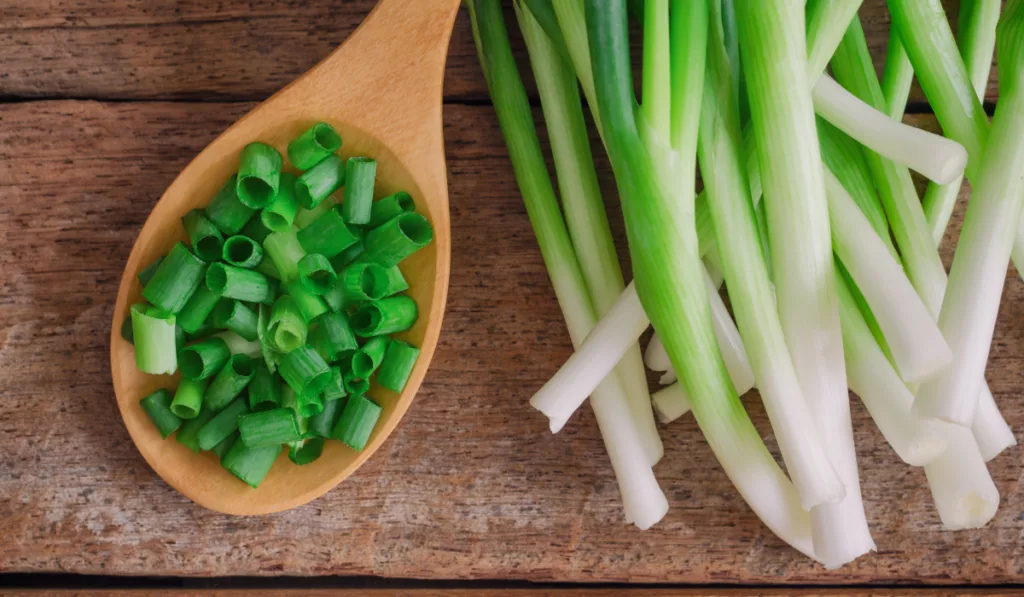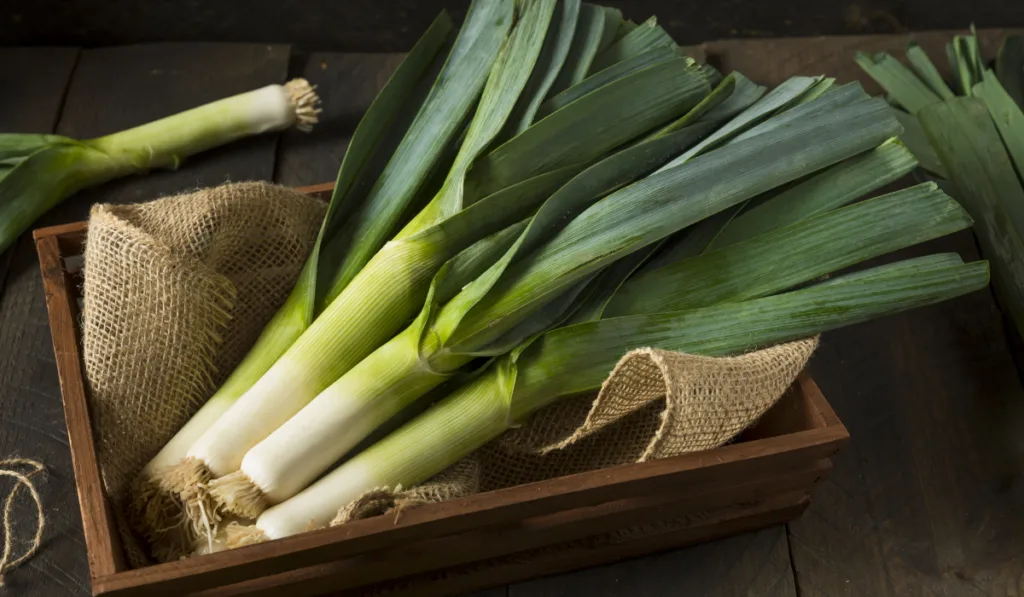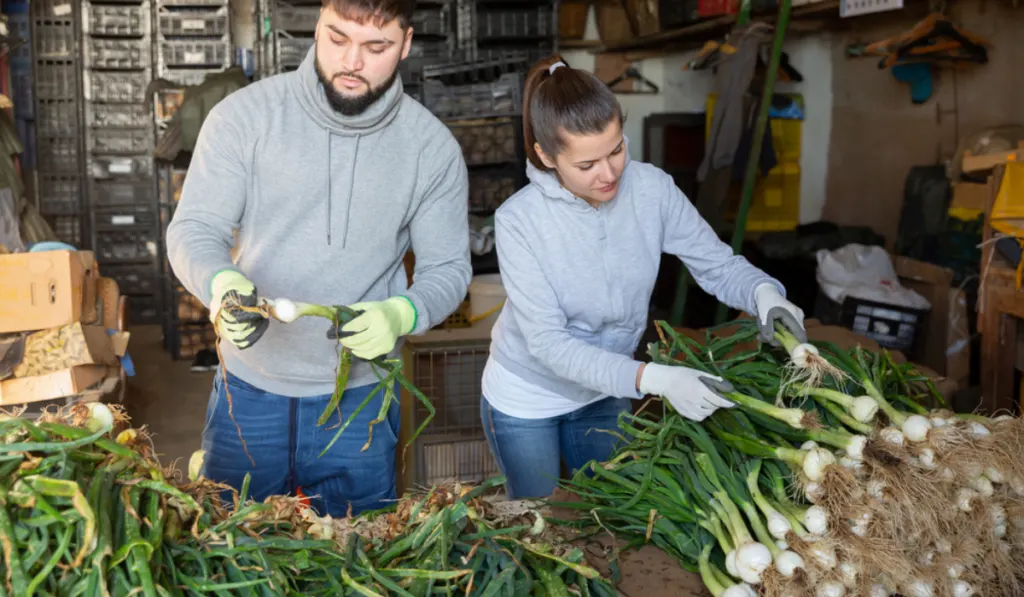Green onions are onion cultivars picked before they attain maximum maturity and are different from the other onions by their taste and appearance. Not all green onion varieties will develop bulbs, but the ones that do are often pale-green with a sleek-linear shape and the characteristic long green onion tops.
Most modern green onion cultivars are a hybrid of Allium cepa and Allium fistulosum, a Japanese bunching onion, meaning that the hybrids can either produce bulbs or have none at all.
Furthermore, there are short-day and long-day green onions varieties, whereby the length of exposure to the sunlight influences the growth and development of the onion, such as the growth and maturity of the bulb.
Green onions are extensively used in a variety of dishes and cuisines for their milder and sweeter taste compared to mature onions, and both their stalks and bulbs are edible.
Green onions have been cultivated for many centuries, China being the leading producer. In the United States, California tops the production states. Others include Texas, Georgia, Arizona, and the Pacific Northwest. During the low seasons, imports from Mexico are always in demand to meet the market’s needs.

Table of Contents
Types of Green Onions
1. Basic Green Onion
The basic green onion is a member of the Allium fistulosum species. In New England and the Mid-Atlantic states, they may be referred to as scallions, while the rest of the US calls them green onions.
Green onions require well-drained, sandy loam soil with cool environmental conditions if you want to grow them. Their harvest time is variable since they can be harvested earlier in the season before they hit maturity or later on when they are fully matured with attached bulbs.
Although many people often confuse the basic green onion with spring onions, the bulbs of green onions are much smaller than those of spring onions.
Green onions are a mild type of onion, and for this, you will notice that they don’t induce tears when you work with them. They can also be eaten either cooked or raw, with the white section close to the stem having the most flavor.
They are used to season a variety of dishes but are especially popular in Asian dishes like stir-fries, along with soups, stews, and Cajun dishes. Scallions thrive in late spring to late summer.
If you want to purchase some, always go for those with firm, bright, and dry white sections, and avoid storing them in polythene bags, as this will make the onions rot quickly.

2. Spring Onions
Being members of the Allium fistulosum species, spring onions are distinguished by their large bulbs and relatively slender stems when compared to green onions.
They are called spring onions because they are one of the first growing things in the garden each spring. However, spring onions have a longer growing season than basic green onions, and for this, they will often have a sharper and more pungent taste than green onions but not as strong as that of yellow onions.
Spring onions are grown for their bulbs which can be roasted like pearl onions or chopped for cooking in various dishes, especially with summer and spring vegetables. They can also be eaten raw, and are a perfect fit for salads.
When mature, their bulbous roots develop a thin papery skin that is often peeled off before using. These bulbs have a combination of a unique crispy, sweet, and savory taste, making it the best fit for a variety of dishes, including those with fish, meat, mashed potatoes, lettuce, and even a wide range of gravies.
For proper storage after harvest, a mesh bag is the most suitable for keeping spring onion bulbs. If you can’t find one, a slightly damp cloth will do the job. Remember to use a few rubber bands to tie them together. When properly stored, spring onions will often last for up to a month.

3. Chives
Being a member of the Allium shoenoprasum species with others like leeks and garlic, chives are considered herbs instead of vegetables.
Chives are distinguished by their large blade-like leaves that often grow up to two feet high. Chives also develop purplish-pink spiky flowers that are as edible as much of the rest of the plant.
Chives are popular in a range of restaurants across the globe because they are blessed with a versatile taste. They are famously applied raw to foods as a garnish because of their onion and garlic flavor that is very light and delicate.
However, this taste can also be very strong and intense, so adding a few chives to your recipe goes a long way.
Chives are packed with essential nutrients, including vitamins A and C, calcium, and potassium.
To cook with chives, use kitchen shears or a kitchen knife to chop them into small fine pieces to bring out their taste and flavor effectively. Chives are popularly sprinkled over recipes like deviled eggs, potatoes, and even dips.
4. Leeks
Leeks are considered to be the sweetest onion amongst all other types of onions and are actually a little bit different because they do not produce bulbs or cloves. Leeks are also larger than regular onions, measuring up to 2 inches in diameter with a height of up to 10 inches.
Leeks have a mild earthy taste with white roots that are cylindrical. When eaten raw, leeks have a very crunchy texture, but when cooked, they become smooth and silky.

Furthermore, leeks possess a unique taste that makes an excellent base flavor for a variety of dishes, including pasta and beans. Leeks can also be pureed to make a potato-leek soup that is especially popular in the winter months.
Leeks thrive in the late winter to early spring seasons and often develop fan-shaped dark leaves when mature.
If you wish to store leeks, remember to chop off the dark green tops first, then find a mesh produce bag for holding them before you put them in the refrigerator. If you do not find a mesh bag, wrap the leeks in a slightly damp napkin or a kitchen towel, and remember to hold them together using rubber bands.
Before cooking with leeks, you need to wash them thoroughly because they may have developed a gritty nature growing through the winter. Although leeks are low in calories, they are especially high in iron and vitamin C.
Cultivation of Green Onions

If you want to cultivate green onions, there are a couple of things to consider.
First, green onions need well-drained loamy soil with mild climatic conditions. They also need a constant water supply, so an effective irrigation scheme should top your priority list.
Green onions cannot compete for resources with weeds because of their shallow roots, so you will need a generally neat garden for the venture.
You may also experience a couple of challenges because onions are vulnerable to hail, wind, and even extremely cold temperatures.
Green onions are ripe for harvest as soon as they attain a quarter to half an inch diameter and the tops reach a height of about 6 – 8 inches.
Green onions are often harvested by hand, gathered, and grouped in bunches. However, once harvested, green onions are highly perishable and need to be immediately cooled. The tops can be left attached to the onions or trimmed off, depending on the market’s preferences.
Green Onion Pests and Diseases
When cultivating onions, you should always look out for pests such as click beetles, nematodes, onion maggots, leek moths, cutworms, bulb mites, armyworms, thrips, and leaf miners.
You can always employ natural pest control methods such as planting pest repelling species and herbs nearby or spraying pesticides to control extensive pest invasion.
You should also watch out for diseases such as bulb rot, bacterial soft rot, downy mildew, yellow onion dwarf virus, smut, rust, grey mold, twister, dumping off, southern blight, wilt, and white tip. There are also remedies available for these diseases at garden centers and online suppliers.

Purchasing and Storing
Depending on the specific onion you want to purchase, avoid brown spots, but instead go for those looking fresh and firm with bright green tops, firm stems, and firm bulbs.
To store them, use mesh bags or slightly dump towers to wrap the onions’ root area to keep them fresh, even during storage.
When picking which onions to store, you should avoid the slimy and wilted ones. The recommended storage temperature should lie around 50°F with a humidity of about 95-100% to effectively maintain the onions texture, color, and quality.
Conclusion
Either with bulbs or no bulbs, green onion varieties have been widely adopted in various kitchens because of their mild and sweet taste, making them a top pick for most chefs. You can find one to meet pretty much any need to make your meals delicious and colorful.
Resources
- https://www.thenibble.com/reviews/main/vegetables/different-types-of-onions.asp
- https://www.producebluebook.com/know-your-commodity/green-onions
- https://www.homestratosphere.com/types-of-green-onions/
- https://food-hacks.wonderhowto.com/news/not-all-green-onions-are-same-heres-they-differ-0171371/
- https://www.masterclass.com/articles/scallions-vs-green-onions-whats-the-difference#whats-the-difference-between-scallions-and-chives
- https://www.escoffieronline.com/the-difference-between-chives-scallions-and-green-onions/
- https://www.allrecipes.com/article/scallions-vs-green-onions/
- https://homeguides.sfgate.com/bunching-onion-varieties-37016.html
